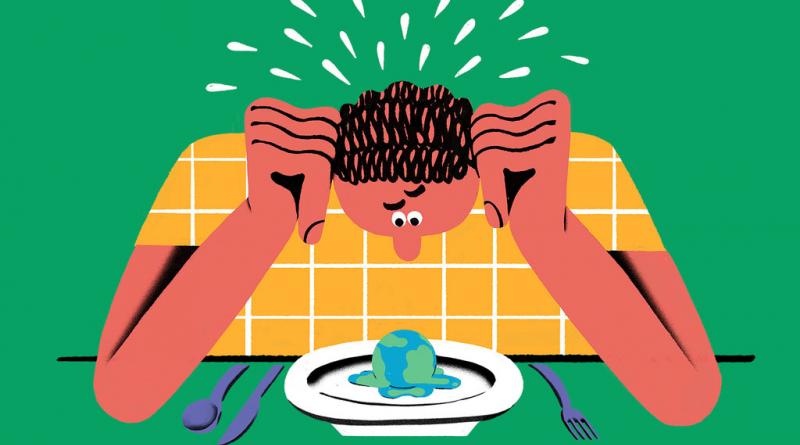You could incorporate more mollusks into your diet. Most Americans don’t often eat them at home, but mussels, clams and scallops are familiar, succulent and easier to cook than you might think. We have recipes for you right here.
As for farmed or wild fish, they can often be a good low-carbon option, but it’s a good idea to check first whether a product is certified as sustainable.
How much impact do milk and cheese have on climate change?
A number of studies have found that milk typically has a smaller climate footprint than chicken, eggs or pork per pound. Yogurt, cottage cheese and cream cheese are similar to milk.
But many other types of cheese, such as Cheddar or mozzarella, can have a significantly bigger footprint than chicken or pork, since it typically takes about 10 pounds of milk to make one pound of cheese.
Wait — cheese might be worse than chicken?
It depends on the cheese. But broadly speaking, yes, if you decide to go vegetarian by, say, eating cheese instead of chicken, your carbon footprint might not fall as much as you expect.
Are some kinds of milk better than others? I pay a lot more for organic milk.
The short answer is that you can’t count on organic milk being better for the climate.
In the United States, that “organic” label on your milk just means that the cows spent at least 30 percent of their time grazing, weren’t treated with hormones or antibiotics, and ate feed grown without synthetic fertilizers or pesticides. That’s certainly appealing to many people. But there’s no requirement that an organic dairy farm have a lower climate footprint than a conventional farm.
To date, studies have disagreed on whether organic dairy farms produce more, less or about the same amount of greenhouse gas emissions as conventional farms do, per gallon of milk. Most likely it varies a lot from farm to farm. The trouble is that there’s nothing about the organic label that tells you anything specific about the climate impact of the carton of milk you’re holding.
Which nondairy milk is best?
Almond, oat and soy milk all have a smaller greenhouse gas footprint than cow’s milk does. But, as always, there are caveats and trade-offs to consider. Almonds require a lot of water to grow, and this has been a problem in places like California. Soy milk tends to be fairly low-impact, as long as the soy is sustainably farmed.
Milk vs. ‘Milk’
Environmental impacts of different types of milk, per liter.
So are you saying I should become a vegan?
If you’re interested in taking the plunge, a vegan diet does have the smallest climate footprint around.
I don’t like vegan food. What would I eat?
If you like pasta with tomato sauce, hummus, avocado toast or peanut butter and jelly sandwiches, you actually do like some vegan food. Eating a fully vegan diet is hard for many Americans to imagine. Some assume that a vegan diet has to include meat “substitutes” like tofu, but that’s not true: There’s ample protein in beans, grains and nuts. And as more people become vegan, plant versions of ice cream, butter and even burgers are getting better all the time. For home cooks, the challenge is often producing a vegan dinner that everyone at the table will eat. We’ve got recipes that can help.
I don’t think I can go completely vegan. What else can I try?
Another approach would be to simply eat less meat and dairy, and more protein-rich plants like beans, legumes, nuts and grains. (Here are recipes that go heavy on beans and grains.)
You could go vegetarian: no meat, poultry and fish, but dairy and eggs are allowed. The advantage here is that the rules are simple, and food manufacturers and restaurants are used to accommodating vegetarians. (We have vegetarian recipes for you that you can cook on a weeknight.)
Eating as a pescatarian, adding seafood to a vegetarian diet, can be a good compromise, and makes it easier to get protein into your meals.
To keep some meat in your diet, try cutting back to one serving of red meat per week, replacing the rest with chicken, pork, fish or plant proteins. This approach is more flexible, but it means more planning ahead and keeping track of what you eat.
Climate-Friendlier Diets
The average drop in food-related emissions when people switch from a typical Western diet to lower-impact ones:
Is organic produce really better than conventionally grown produce?
Organic produce is grown without synthetic fertilizers or pesticides, which is important to a lot of people. But that doesn’t mean it’s necessarily better from a climate perspective. In some cases, it can be a bit worse — organic farms often require more land than conventional farms. That said, organic farms’ climate impact can vary widely from place to place, and the organic label, on its own, doesn’t give you great information on the food’s carbon footprint.
Should I worry about whether my produce is local and seasonal?
In general, what you eat matters a lot more than where it comes from, since transportation accounts for only about 6 percent of food’s total climate footprint. That said, there are a few things to consider.
Anything that’s in season where you live, whether you buy it at a local farmers’ market or at a supermarket, is usually a good choice.
Things get trickier when it comes to out-of-season produce. Some fruits and vegetables that are shipped by plane can have a surprisingly hefty carbon footprint. During the winter, that may include asparagus or blackberries — produce that’s perishable and needs to move quickly between distant places. By contrast, apples, oranges and bananas are often shipped by sea, which is more fuel-efficient. Plenty of cold-climate vegetables, like carrots, potatoes and squash, can be stored after the fall harvest and last through the winter.
In some cases, though, there can be an advantage to food that’s shipped in from elsewhere. If you live in the northern United States during the winter, it can be better to buy a tomato trucked in from California or Florida than to buy a local variety that was grown in an energy-intensive heated greenhouse.
Is food waste a big part of the climate change problem?
Yes. By some estimates, Americans end up throwing out roughly 20 percent of the food they buy. That means that all the energy it took to produce that food was wasted. If you’re buying more food than you actually eat, your climate footprint will be bigger than it needs to be. So minimizing waste can be a pretty straightforward way to curb emissions.
How can I reduce my food waste?
There are lots of possibilities. If you cook, start with meal planning: Over the weekend, take 20 minutes to lay out three weeknight dinners, so that you buy only the food you plan on cooking. (A similar rule applies if you eat out: Don’t order more than you need.) Trim and wash your produce before putting it away, to make it easier to use. Be vigilant about eating or freezing the food in your refrigerator, instead of letting it spoil.
It’s also worth remembering that “sell by” labels on food don’t mean the item absolutely has to be tossed out after that date; they’re usually manufacturer suggestions for peak quality. Many foods (with the exception of baby formula) can still be safely consumed after that date.
Should I be composting?
If you’re able to, it’s not a bad idea. When food is tossed into a landfill along with your other garbage, it begins to decompose and release methane into the atmosphere, where it warms the planet. Although a few American cities have started capturing some of this methane and recycling it for energy, most do not.
When composting is done right, the organic material in leftover food is converted into compost that can help grow crops, and methane emissions are cut significantly. Some cities, like New York, have started setting up centralized composting programs or curbside pickup. Or you can follow these tips to compost at home.
Should I use paper or plastic bags?
Paper shopping bags appear to be a bit worse from an emissions standpoint than plastic bags, although the plastic bags at supermarkets can’t typically be recycled, and create waste that sticks around for much longer. But in general, packaging makes up only about 5 percent of global food-related emissions. What you eat matters a lot more for climate change than the packaging it comes in.
That said, it’s a fine idea to reuse the bags that you do get, or to buy a reusable bag (as long as you keep it and use it often), or to minimize plastic bags when picking out produce. Other plastics at the store, like soda bottles or milk jugs, are tougher to avoid, but those can often be recycled.
Does recycling really do anything?
It can help, though it’s not as effective as reducing waste in the first place. Recycling aluminum, plastic and paper can cut energy use and curb emissions. But make sure you’re recycling properly; follow these tips to make sure your recyclables don’t just end up in the landfill.
Why aren’t there labels in the grocery store explaining the carbon footprint of different foods?
Some experts have argued that there should be environmental labels on food, similar to nutrition labels. In theory, these labels could help interested consumers pick out lower-impact products and give farmers and producers more incentives to curb their emissions.
A recent study in the journal Science found that products that look very similar at the grocery store can have widely different climate footprints depending on how they’re produced. One bar of chocolate may have the same climate impact as driving a car for 30 miles — if rain forests were cleared to grow the cocoa — while another chocolate bar may have very little climate impact at all. But without more detailed labeling than exists today, it’s extremely difficult for a shopper to figure out the difference.
That said, a really detailed labeling scheme would likely require a lot more monitoring and emissions calculations, so it could take a fair bit of effort to put a system like this in place. For now, most shoppers will have to get by using rough rules of thumb.
April 2019





